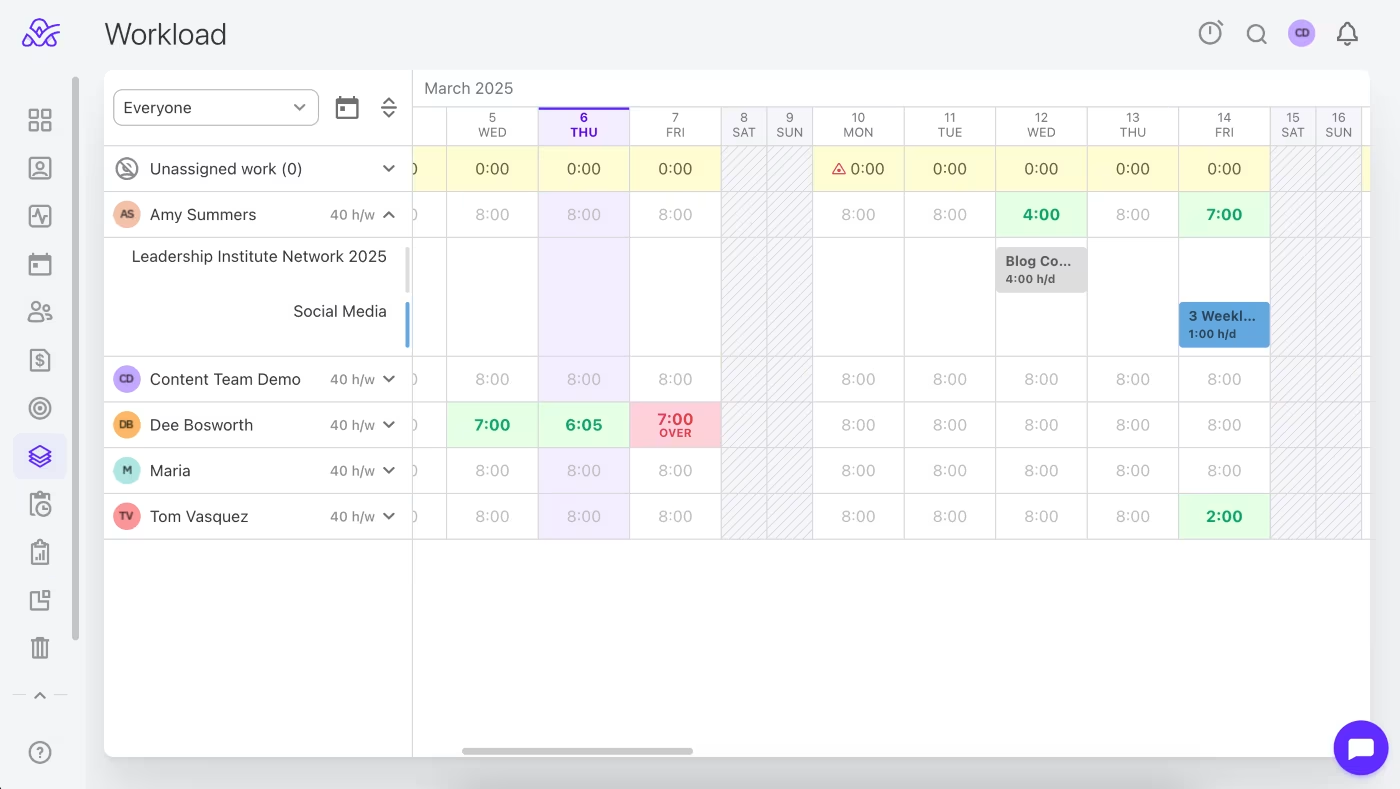According to SmartBrief, 28.57% of leaders have said that they distribute the workload very well among team members, with 61.9% of them saying that they do it well. Only 1.73% have admitted to doing a poor job.
However, it’s easy to suspect that they haven’t been completely honest, because an unbalanced workload is among the leading causes of burnout, which in itself happens to just about any employee at some point.
On top of that, workload imbalance can create a rift inside your team and cause resentment (we talked more about it on our post on what is workload management). Then, they start to miss deadlines, disengage, or even quit.
To prevent that from happening, we take a look at how you should distribute work evenly, what to do, what not to do, and which tools and practices can make your job easier.
Assess the current state
Once you have a workload balance issue in your agency or organization, you should start by identifying the reasons behind it. Usually, workload balance occurs due to one or more of the following culprits:
- Poorly communicated expectations
- Unrealistic deadlines
- Inefficient workflows and processes
- Limited resources
Now, while identifying the root cause(s) of workload imbalance is crucial, it’s even more important to gauge how the said imbalance is impacting your team members. More specifically, how it’s affecting their morale, engagement, collaboration, as well as the quality of their work.
Here are some of the methods you can use to get a clearer picture:
- Conduct surveys and polls among members of your team
- Organize feedback sessions to gather information directly
- Analyze workload charts for additional data and insights
Next up, you should focus on the following:
- Determine task urgency: Start by talking with team members first to define which tasks are high-priority and then distribute the workload accordingly. More on this in the next section.
- Establish individual and team workloads: Consider both the qualitative and the quantitative aspects. In other words, analyze workload based not just on work volume and complexity, but also your team members’ skills and strengths for better employee-task matching.
All of this will help you understand your team’s actual capacity and identify heavy workloads before they become an issue.
Get task prioritization right
The easiest way to create a workload imbalance on your team is to think of each task as a high-priority one. Let us save you the suspense: it’s not.
Unless your team has the capacity to handle every task as if it’s the most important one, you’re going to have to decide which one matters to your organization the most and when.
So how do you prioritize tasks then? Here are some of the tried-and-true methods:
Determine which tasks have the biggest impact: Not just in terms of emergency, but also based on parameters that matter to your agency or business, such as ROI or bottom line.
Use any of task prioritization methods to figure which tasks needs to be done ASAP, which can be pushed back or delegated, and which ones can be dropped altogether.
Let your team know why a task matters: It’s not about handing your team or its members a list of tasks to complete. Obviously, it needs to be done, but letting them know why something is high-priority helps them understand the importance of the task. It also makes them more likely to commit.
Check in with your team: Priorities are not set in stone. They can change easily, so make sure to have everyone on the same page in terms of what needs to be done.
Use workload management tools
While you can organize your own and your team’s workload using spreadsheets, emails, and notes, you would just be creating more work for yourself and disrupting the workload balance in the process.
A better way would be to use workload management software, such as ActiveCollab, to keep track of all the work that needs to be done in a user-friendly way, and how to distribute that workload with balance in mind.
ActiveCollab, which also functions as a productivity workspace and a project management platform, has a dedicated Workload View, which is a feature that enables you to:
Get a real-time snapshot of your teams’ workload: Quickly zero in on who is doing what, which employees are overloaded, and which ones aren’t being utilized properly. You can also view unassigned tasks and distribute them based on team members’ current availability and capacity.
Optimize individual and team workload: Assign the right tasks to the right people based on skills and availability to balance the amount of work and improve productivity.
Identify Potential Overload and Scale Your Operations: By being aware of where your team is being stretched thin, you can make a decision about hiring additional people or getting seasonal help.
Check out how Workload works right here:
Let the leadership know about the workload imbalance
Your agency’s leadership is going to focus on keeping the organization operational and profitable, it’s what it does, so it’s not going to necessarily be aware of workload imbalance on your team.
It’s up to you to bring them up to speed before it starts to affect other parts of the organization. And instead of formulating it as a complaint, offer a solution-oriented conversation, as it will be more likely to get traction with your leaders.
This is where you can leverage the power of the data that ActiveCollab collects for you:
- Show how tasks are distributed among team members, and which ones are always overworked
- Explain how an improper workload balance affects team performance and morale
- Provide visual and data-based evidence to support your claims
Once your agency’s leadership is aware of the issue your team is having, they can respond accordingly in a number of different ways, including:
- Redistribute tasks among teams and team members
- Hire additional staff or freelancers to help balance the workload
- Push back deadlines so that the individual workload is kept within reasonable limits
- Readjust project scope
Check team members’ availability
In an ideal situation, every member of your team would be available at all times, which would make your job of balancing workloads a lot simpler. However, in real life, things don't always go according to plan.
But, even if they do, you still need to think about less or more predictable scenarios, such as team members getting sick or taking a well-earned vacation. This isn’t a problem in itself, because you can distribute the work across other team members in order to bridge the gap in resources.
So, before you start shifting the workloads around, make sure to check who is actually available, and if they can take on additional work. You can use ActiveCollab for this as well to avoid assigning work to individuals who are already at their maximum capacity, and give it to those who have an opening coming up soon.
But even with powerful software tools in your arsenal, simply talk to your people, and learn which ones are quietly nearing burnout, and which ones are ready to take on a bigger challenge. And most of all, cultivate an atmosphere in which they feel comfortable telling you that.
Play to your team members’ strengths and skills
We’ve established that balancing the workload is about who does what, when, and how much, but there is another aspect that you can use to your team’s advantage.
Each individual on your team brings something unique and different to the table, and that includes different skills and preferences, both of which need to be taken into account when balancing and distributing the workload.
For example, if you are managing a content team, and one of the writers has a technical background, they will tend to do well with writing user guides, tutorials, and technical documentation.
Having the appropriate skills and experience, they will jump at the chance to complete the task, and will probably do so much faster than someone who is dealing with that type of content for the first time ever. Plus, that team member’s job satisfaction will also get a boost.
If team members’ strengths and preferences aren’t immediately obvious, you can organize feedback sessions and performance reviews during which you will inquire about their interests and areas they would like to explore.
Also, pay attention to how team members interact with each other in the office or during team-building exercises. Some people may exhibit qualities that would make them good leaders, for example.
Talk to your team members and make adjustments
The most obvious thing about workload balancing is in the name itself. Imagine you are trying to balance yourself while walking on a tightrope. It’s not a one-time thing, because you have to make constant adjustments in order to not fall down.
In that aspect, workload balancing is exactly the same. Because it’s not a “set it and forget it” endeavour, you will need to fine-tune constantly. How do you do that? As always, talk to your team. It always works.
Here are some of the questions you can ask your team members:
- Are they able to manage their current workload?
- Do they feel like they have too much on their plate?
- Do they feel bored or unchallenged?
- What are some projects/tasks they would like to work on?
And this sort of communication doesn’t even have to be a formal one-on-one review. It can take on the shape of a casual water cooler conversation as well. Once your team members realize that you care about their input, they will start to open up.
Once you have the information you need, go ahead and make those workload adjustments, track their results using ActiveCollab, and then circle back and check in with your team again.
Foster cross-functional training and skill development
If you want to play the long game when it comes to balancing your team’s workload, one of the most effective methods for it is cross-functional training.
By enabling your team members to expand their skill sets, they will be more able and ready to jump in and pick up someone else’s workload. Plus, it makes your job of doing workload management a lot easier, because you can now choose who can step in.
This is where we circle back to open and ongoing communication. Identify which team members can benefit from learning new skills. For example, one of the people on your marketing team could branch out into sales or customer support. Or you could have a developer who is interested in project management.
How do you facilitate cross-training? We recommend one or more of the following:
- Organize workshops and training sessions
- Set up an initiative where team members can mentor each other
- Create cross-functional teams
Cross-training helps your team on multiple fronts. In terms of workload balancing, you have a team that is more resilient to workload and personnel changes. Also, learning new things boosts employee engagement and team cohesion.
Last but not least, by learning each other's skills and viewing tasks and projects from other team members’ points of view, your employees will be more understanding of each other.
Acknowledge and reward team efforts
This one takes a less tangible approach to balancing your team’s workload. On the surface, praising your team and its members for their effort doesn’t appear to have anything to do with the workload balance. But, its impact is immeasurable.
When your team members feel appreciated and valued, it keeps them motivated and engaged. It also means they will be productive and willing to keep the team running like a well-oiled machine.
How do you acknowledge and reward team efforts? Both materially and immaterially, including:
- Bonuses or raises
- Extra time off
- Team-building activities
- Giving a shout out in a team meeting
And you don’t need to wait for huge milestones, either. Saying a simple “thank you” in front of the entire team to the person who put in the extra effort during the week can go a long way.
Appreciating your team member for their wins, no matter how big or small, boosts their confidence and enables them to take ownership of their work. And once the entire team is in it together, workload imbalance becomes a thing of the past.
Conclusion – Achieve and maintain a perfectly balanced team workload with ActiveCollab
Ultimately, workload balancing is all about the people in your team and your organization. This means being receptive to their interests, needs, and capabilities, as well as responding accordingly.
Once that happens and the workload is balanced, good things happen. There is more collaboration, higher productivity, more understanding among team members, and less burnout and disengagement.
In order to support workload balancing, it’s essential to have the right tools. ActiveCollab enables you to keep your team’s workload balanced by gauging its actual abilities, and assigning tasks to the people in accordance with their availability and capacity.
Get on top of your team’s workload balance and sign up for our 14-day free trial, or book a demo, and we will show you why ActiveCollab is the only workload management tool you will ever need!


